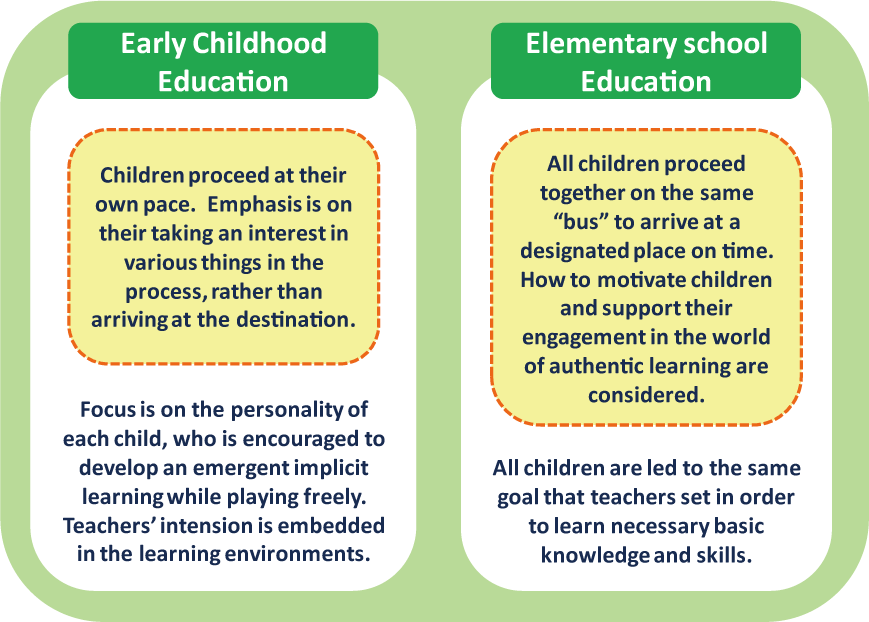This article is translated and reprinted from the Benesse newsletter, "Thinking about the Future of Infant Education," Special Issue 2012 (The contents are only available in Japanese).
There is no concrete method for cultivating children's emergent implicit learning, but flexible support is needed according to the developmental pace of each child. We interviewed Professor Kiyomi Akita at the University of Tokyo, who served as vice chairperson of the Committee on Transition from Preschool to Elementary School, about the concepts and practical methods of such support to be shared among teachers.
Interest in learning is triggered the same way in young children and adults
What kind of factors trigger a child's interest and involvement in learning? I believe that there is little difference between children and adults when being inspired to learn. For example, if we are asked to cook the same dish every day as routine work, we won't think of improving cooking skills. In real life, however, we are inspired to improve our cooking on such occasions as trying new ingredients or preparing dishes to entertain friends. The same can be said for young children: their interest in learning can be inspired by various factors during their play.
There are some adults who do not continue being motivated to learn. This largely depends on whether they had sufficient experience to develop their emergent implicit learning during the early childhood stage and successfully linked the experience to subsequent learning in elementary school and thereafter.
To obtain insight into cultivating children's emergent implicit learning, let's compare concepts of early childhood education and elementary school education. Elementary school education is just like instructing all children on the same train or bus to arrive at a designated place on time. They are allowed some freedom in behavior such as looking out the window, etc., but in principle, they should advance towards the same direction as a group. On the other hand, early childhood education lets children stroll at their own pace. Children are encouraged to have confidence in their ability to proceed at their own pace, and are expected to take an interest in various things in the process. Arriving at their destination is not the first priority.
But even taking a stroll requires a map. Teachers are expected to prepare a map that shows the direction of children's development, and based on the map, to instruct children to develop their knowledge and skills at their own pace. In this regard, it can be said that teachers need to have the eyes of a hawk--a panoramic view of child development, and at the same time, have the eyes of an ant--a close-up view of children's personality.
To facilitate young children's smooth transition from preschool to elementary school, teachers need to understand how to make the move from early childhood education to elementary school education. Therefore, it is important for them to read the elementary school education guidelines and observe classes of the lower grades of elementary school.
The key to encouraging learning is to know what children are interested in
Then, what kind of support should teachers provide for children in order to encourage them to learn? In order to find the answer, it is important to understand situations in which children start to learn.
First of all, do children of pre-school age learn things at the verbal instruction of teachers such as "Do XXX", as in elementary school? This may be effective on some occasions, but will not cultivate children's emergent implicit learning. Children can learn on their own by being deeply involved in "people, events and things" through the support of teachers.
For example, when a child finds an insect, a teacher will say "Let's look it up in the picture dictionary." This is a quite common practice, and may be reasonable if the child only wants to know the name of the insect. However, if the child's interest goes deeper than just knowing the name, for example, wondering why there are many insects under the stone, or why there are same insects but in different sizes, the teacher should support the child in developing further knowledge of insects. In other words, finding the direction of a child's interest can be the starting point for cultivating the child's emergent implicit learning.
We should note that children will not always start learning in the way teachers expect. Let's say, for example, that a child notices a piece of plastic sticking to the body because of static electricity, which could be a good opportunity for cultivating children's emergent implicit learning. A teacher should not miss this opportunity and encourage the child to look into the phenomenon together, or ask other children to do the same experiment or new experiments with different materials.
"Widening" and "deepening" children's learning by providing a relaxing environment
Next, I will explain two important factors to create a learning environment in preschool that can encourage children's learning habits.
First, as you well know, it is important to provide children a relaxing and secure environment in which each child can feel that they are "accepted" by teachers and classmates. Children never show their interest towards learning when they feel uneasy or nervous.
Second, teachers should share the concept of "widening" and "deepening" support for children's activities. "Widening" support means linking a child's play activity to that of other children, or developing the activity by using different materials or through different situations, while "deepening" support means instructing children to move on to the next step, based on the predicted outcomes of activities relating with their previous knowledge and experiences.
For example, deepening support is necessary to maintain the interest of a child who is trying to stack a tower of toy blocks as high as possible. Through such support, the child will learn some clues such as "the base should be large enough to hold a high tower" and develop his play further. A teacher can also help the child play with other children through a train game, using the toy blocks as a station, which is a form of widening support. There is no clear boundary between these two types of support, but teachers can flexibly utilize them depending on the situation to develop children's activities.
Teachers also need to have the skill of predicting the progress of children's play. For example, when children are making a raft with milk packages, teachers have to prepare supporting instructions for the next stage, predicting how big children can make a raft, how they can play with the raft and so on. Widening and deepening children's play activities can be accelerated if teachers predict the progress of the activities based on children's developmental stages as well as their play and life experiences, and prepare several types of support for them.
Developing the skill of predicting the progress of children's play through on-site training in the classroom
However, for inexperienced teachers, it is difficult to predict the progress of children's play activities in the long run; and as a result, the teachers often end up only dealing with issues that their students currently face. This will hinder the development of children's creativity and thinking skills.
In contrast, experienced teachers have a longer-term perspective such as "The child cannot do this task at the moment, but will be able to do it gradually with his classmates after six months" and determine that "there is no need to provide instructions for the child at this stage." This is very important to cultivate children's emergent implicit learning.
Therefore, it is necessary to create a working environment in kindergarten in which every teacher can develop the skill to predict children's play activities. There are methods in which young teachers attend and observe the classes of experienced teachers and check the education records of the previous year, which can be useful to understand the objectives of activities and the development process of children. On-site training is also helpful for teachers in developing their prediction skills, by sharing education records, photos and videos of children's activities and discussing children's play and support with other teachers.
Cultivating children's emergent implicit learning is essentially different from the concept of early education. I hope that all teachers will understand the importance of supporting and nurturing the learning potential of children.
On "Thinking about the Future of Infant Education"
Benesse provides information that will improve the quality of early childhood education and care to those involved in the field. Based on extensive research and survey data, it considers the teachers and their aims in seeking to raise the quality of child education and care together.




 Kiyomi Akita
Kiyomi Akita










